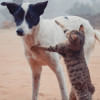The plight of stray animals in Dhaka

Animal abuse, like all forms of abuse, cannot be tolerated. So, why do we routinely hear horror stories or watch videos of stray animals getting abused on the streets of Dhaka?
Strays -- dogs, cats, and birds -- are a common sight on the streets of the city, and they lead lives marred by abuse.
Are we so incapable of understanding another being's suffering?
Joyeeta Trisha, a freelance photographer and an animal rights activist, remarks, "I feel heartbroken every time I see the miserable condition of these strays. From pouring hot water to kicking them -- why people treat these innocent beings so horribly and with utter disrespect is beyond my comprehension."
Joyeeta along with her friend Julia Yeasmin have been trying to raise awareness against animal violence through monthly campaigns in different parts of the city, including Mirpur and Hazaribagh, where stray dogs and cats are frequently abused.

Joyeeta explains, "We are organising these campaigns with our resources but how long or to what extent we can keep doing this? We have repeatedly asked for help from numerous animal welfare organisations -- yet, no one is willing to support us. This unsupportive behaviour is discouraging for us, who want to do something for these animals."
Every day for these strays is a battle for survival. They spent their days roaming around the roads and alleys, scavenging nutrition from the discarded food in the dumpster. With the city's overpopulation and limited resources, finding food and shelter becomes a constant struggle – leading to malnutrition and exposure to the harsh elements.
Julia Yeasmin, a school teacher by profession and an animal lover, strongly opposes any form of animal abuse and regularly feeds stray dogs in Chandrima Udyan, along with creating awareness against animal violence for the last four years.

"Stereotypes and cultural beliefs also play a role in the neglect and abuse of stray animals," opines Julia, adding, "Some people hold misguided notions about certain animals being bad omens or carriers of diseases, such as dogs, and this can lead to mistreatment of these creatures. So, if we want to change people's negative perceptions, we need to educate them first -- only then, violence against animals might stop."
Many people in the city simply do not care or are unaware of the suffering these animals endure. The mere presence of strays is a nuisance – a complaint often echoed by the residents. But what sort of troubles do we see them causing apart from asking for some food and care?
Ferdous Utsho, an amateur photographer and animal lover, observes, "One of the unfortunate reasons stray animals are abused is because of their appearance, as unlike pet animals, they are not so well-groomed. So, abusers use this reason as an excuse to abuse them."

Despite the grim situation, there are rays of hope in Dhaka. Now and then, we see young activists caring for the stray animals. Of course, it is an act of compassion, but this act should be done in the right way, if possible, after consulting with a professional.
We can leave food and fresh water in designated areas and support spaying and neutering programmes to control the stray population. This humane approach prevents further suffering and reduces the number of strays on the streets.
The plight of stray animals in Dhaka is a complex issue with deep-rooted causes; nevertheless, our goal is not just to rescue these animals, but also to create a more compassionate society that values the lives of all creatures, no matter their form.

 For all latest news, follow The Daily Star's Google News channel.
For all latest news, follow The Daily Star's Google News channel. 








Comments